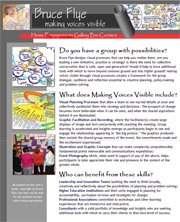I’ve talked to a couple of faculty in our
 Mike Dorsey, a painter and dean emeritus, was also encouraging, citing the emotional power of images. Mike suggested that the fact that the wall graphics are being produced live and with the risk of error adds a way of capturing attention. For this reason, he suggested caution in facilitating with digital tools: they lend the ability to fix an error, a group knows that and the effect is diminished. Hmmmm…..I’m not totally positive, but it does add to the worry I feel over just how few blank flat walls are available on a college campus.
Mike Dorsey, a painter and dean emeritus, was also encouraging, citing the emotional power of images. Mike suggested that the fact that the wall graphics are being produced live and with the risk of error adds a way of capturing attention. For this reason, he suggested caution in facilitating with digital tools: they lend the ability to fix an error, a group knows that and the effect is diminished. Hmmmm…..I’m not totally positive, but it does add to the worry I feel over just how few blank flat walls are available on a college campus.
I wonder too if a group shares the experience of the facilitator’s contact with the paper. In an earlier post I told of the experience of artist William T. Williams touching a canvas, and occasionally I experience something sensual when I really mash the wide side of a stick of cheap chalk across clean white paper. Can a group have that same kind of feeling, and obtain a sort of affirmation not only from seeing the record of their thoughts but also from a near-tactile experience of the recording?
In recent months I’ve had opportunities to graphically record and facilitate, and I have also used The Workshop Method on a Stickie Wall. I don’t understand the difference in the way groups respond to each method, and an experience in a session in
I co-facilitated the meeting with 
The card session was rather detail-oriented. We pulled a lot of information out of our participants, and then worked through a process of getting it organized into meaningful content. As usual I was amazed and impressed with how well it works. Following that portion,
Before letting everyone get away, I asked for reflections on the methods we had used and their effectiveness. I don’t believe anything was volunteered about the Stickie Wall and cards; I asked a question or two about them, received a short positive answer and then the conversation floated right back around to the graphic recording, which went on for a while. One comment that stands out in my mind was that no one had ever seen notes AND relationships among them coming together at the same time.
From a personal standpoint, that recording session let me go off into some other world.


No comments:
Post a Comment